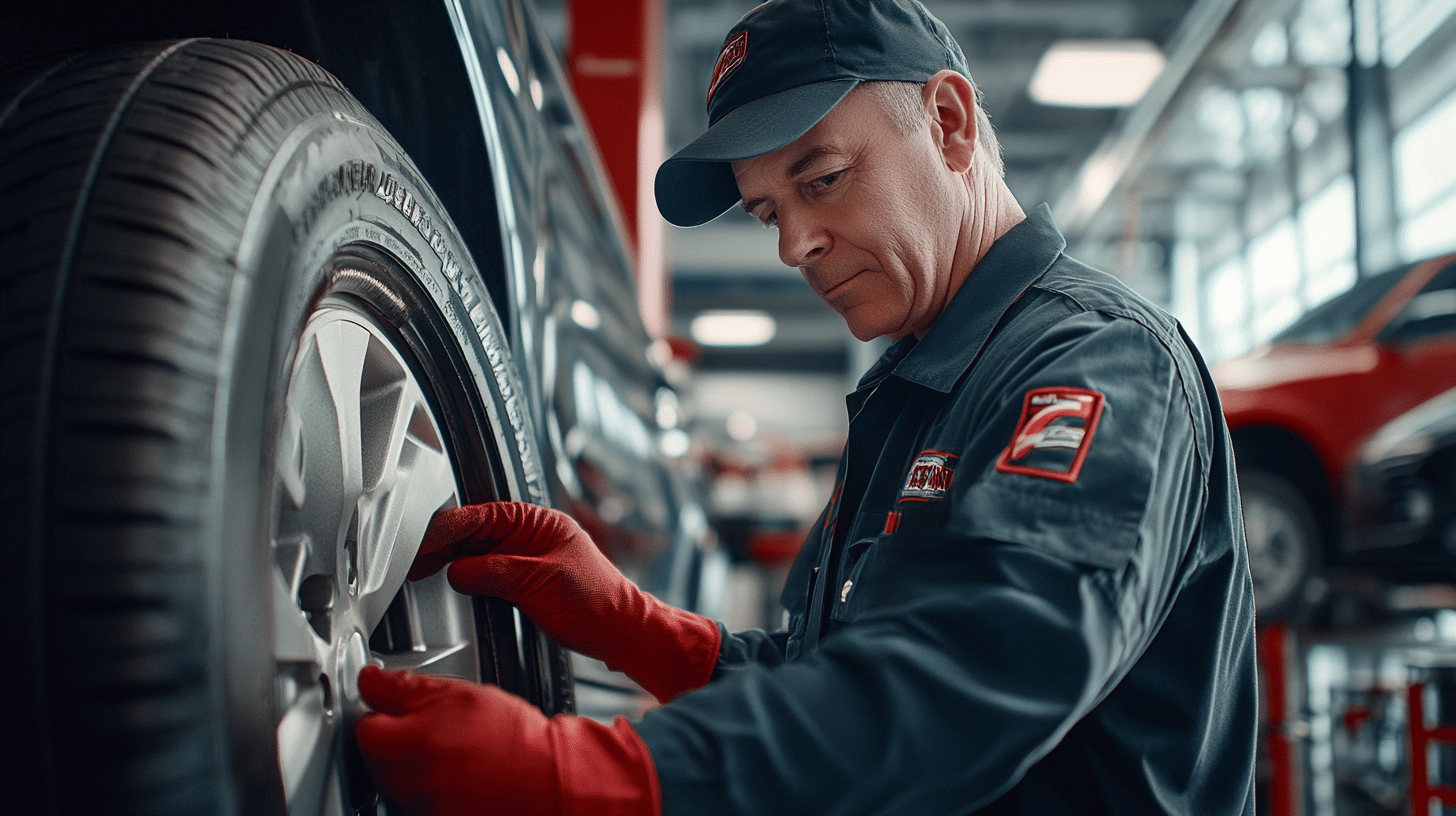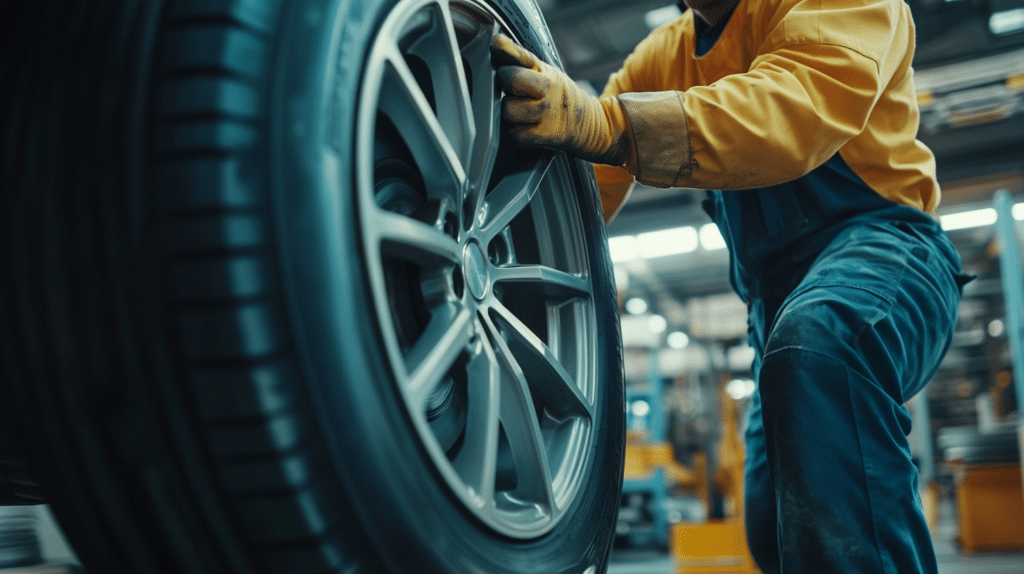Tire wear is a fact of life for every driver. You’ve likely noticed uneven tread on your tires, affecting your vehicle’s performance and safety.
At Firestone, we understand the importance of proper tire maintenance. This blog will explain the cost of it and why tire rotation is crucial for your car’s health.
We’ll explore Firestone’s tire rotation service, discussing its costs and benefits.
You’ll learn about the ideal rotation schedule, what happens during the process, and how it can extend your tire’s life.
By the end, you’ll have all the information needed to make an informed decision about your vehicle’s tire care.
Firestone Tire Rotation Cost
When it comes to tire rotation costs at Firestone, customers have two main options.
For those who purchase tires directly from Firestone, there’s good news: tire rotations are free for the life of the tires.
This perk adds significant value to your tire investment, providing long-term maintenance savings.
If you didn’t buy your tires from Firestone, don’t worry. The standard rotation service is available at a budget-friendly price of about $20.
This consistent pricing across most Firestone locations ensures transparency and helps customers plan their maintenance expenses.
The $20 fee covers more than just tire rotation. It includes a thorough tire inspection, tread depth check, and other complementary services.
Many customers have shared positive experiences about the cost-effectiveness and quality of Firestone’s tire rotation service, highlighting its value for money.
Benefits of Tire Rotation at Firestone
- Extended Tire Life: Regular tire rotation at Firestone helps your tires last longer. By moving tires to different positions, wear is spread out evenly, preventing any single tire from wearing out too quickly. Front tires wear faster due to steering and braking, so rotation balances this out.
- Improved Fuel Efficiency: Well-rotated tires can help you save on gas. Even wear keeps tire pressure optimal and reduces road resistance. This means your engine doesn’t have to work as hard, using less fuel.
- Enhanced Vehicle Performance: Proper tire rotation leads to better handling and traction. When all tires wear evenly, your car responds more predictably when you steer. This gives you a consistent driving experience across different road types. It also improves your safety, especially in bad weather or emergencies.
By choosing Firestone for regular tire rotations, you invest in longer-lasting tires, better fuel economy, and improved vehicle performance and safety.
Additional Services Included with Firestone Tire Rotation

1. Tread Depth Checks
Every tire rotation at Firestone comes with a free tread depth check. This is key for maintaining good traction, handling, and overall tire safety.
Proper tread depth is vital to prevent issues like hydroplaning and ensure effective braking, especially in wet conditions.
By spotting tread depth problems early, Firestone helps you avoid uneven wear that could lead to early tire replacement or safety risks.
2. Tire Inspection
Firestone includes a thorough tire inspection with each rotation at no extra cost. This check ensures your tires are damage-free, properly inflated, and in good shape.
Technicians look for nails, punctures, or sidewall damage that could affect safety. They also check tire pressure, which is important for best performance and fuel efficiency.
This detailed inspection helps catch any issues early, contributing to the safety and longevity of both your tires and vehicle.
3. Brake Inspection
When you get a tire rotation at Firestone, you also receive a free brake inspection. This check is vital for your safety on the road.
During this inspection, Firestone technicians examine key parts of your braking system, including the brake pads, rotors, calipers, and brake fluid levels.
They look for signs of wear, damage, or potential leaks that could affect your ability to stop quickly and safely. This thorough check helps catch brake issues early, potentially saving you from more expensive repairs down the road.
4. Suspension Check
Along with tire rotation, Firestone offers a free suspension check. Your car’s suspension system plays a big role in how your vehicle handles and how comfortable your ride is.
During this check, Firestone’s experts examine important suspension parts like shocks, struts, and control arms for wear, damage, or any signs that your wheels might be out of alignment.
A well-maintained suspension keeps your car stable and comfortable, making your drives safer and more enjoyable.
5. Battery and Oil Check
As part of the tire rotation service, Firestone often includes a quick look at your car’s battery and oil levels. These checks are important for keeping your vehicle running smoothly and reliably.
For the battery check, technicians test how well it holds a charge and its overall health. This helps ensure your car starts reliably and can power all its electrical systems.
The oil check involves looking at the oil level and condition. Oil is crucial for keeping your engine running smoothly and preventing wear.
6. Warranty Benefits
Firestone stands behind their work with a solid warranty. The tire rotation service comes with labor coverage for 12 months or 12,000 miles, whichever comes first.
This warranty shows Firestone’s commitment to quality and gives you extra assurance about the service.
If you bought your tires from Firestone, this warranty is even more beneficial. It provides additional protection for your tire investment, making the rotation service not just routine maintenance but a way to safeguard your new tires.
By combining these complementary services with warranty benefits, Firestone offers more than just a basic tire rotation.
You’re getting a package that takes care of your tires from all angles. When compared to competitors, Firestone’s offering stands out for its comprehensive approach to tire care.
Why Choose Firestone?

Firestone stands out as a top choice for tire rotation and maintenance thanks to its team of skilled, certified technicians.
These experts bring extensive training and experience to every service, ensuring precise and effective tire care.
Their attention to detail goes beyond the basics, carefully examining each tire and its placement for optimal results. This meticulous approach minimizes errors and maintains high-quality standards.
Firestone’s longstanding reputation in the automotive industry, built on decades of commitment to quality and customer satisfaction, makes it a trusted name nationwide.
Many customers return to Firestone time and again, citing consistent reliability and excellent service.
This combination of expertise, thoroughness, and trustworthiness makes Firestone a smart choice for drivers looking for dependable tire care and vehicle maintenance.
Conclusion
Tire rotation at Firestone offers more than just extended tire life. It’s an investment in your vehicle’s safety, performance, and your wallet’s health.
With skilled technicians, competitive pricing, and additional services included, Firestone provides excellent value for your money.
Regular rotations can lead to significant long-term savings by preventing uneven wear and improving fuel efficiency.
Whether you’re taking advantage of free rotations with Firestone-purchased tires or paying the standard $20 fee, you’re ensuring your vehicle stays in top condition.
Remember, properly maintained tires are crucial for safe driving in all conditions. Don’t wait until you notice uneven wear or handling issues.
Make tire rotation a regular part of your vehicle maintenance routine at Firestone.
Your car—and your budget—will thank you for it.
Frequently Asked Questions
How Often Do You Need to Rotate Tires?
Most car makers suggest rotating tires every 5,000 miles or six months. Check your car’s manual for specific guidance. Driving habits and conditions can also affect this timing.
Does Firestone Do Free Air in Tires?
Yes, Firestone Complete Auto Care offers free tire inflation. They also provide a free tire inspection when you visit for air. If you need new tires, they can help with that, too.
What is the Best Tire Rotation Pattern?
The best pattern depends on your car’s drive type. For front-wheel drive vehicles, the forward cross pattern works well. This moves front tires straight back, while rear tires move forward and switch sides.


